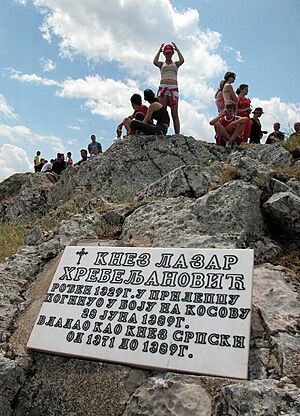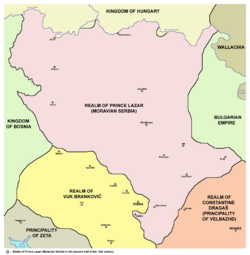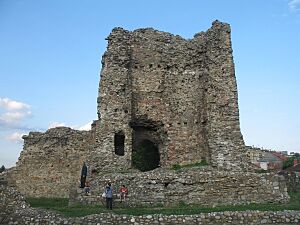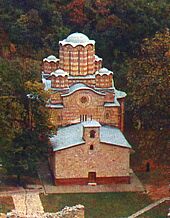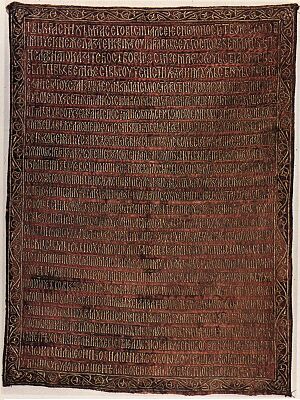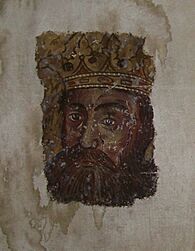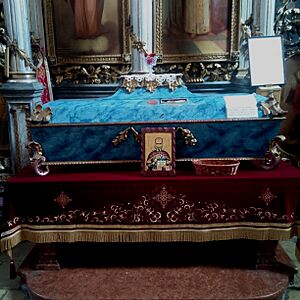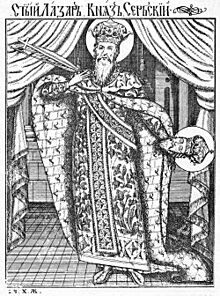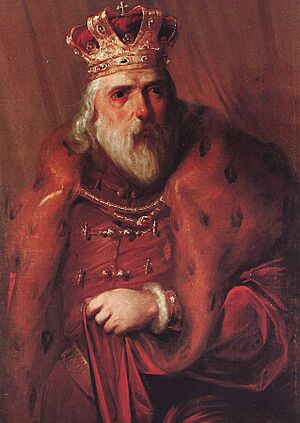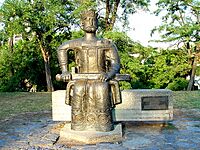Lazar of Serbia facts for kids
Quick facts for kids SaintLazar Лазар |
|
|---|---|
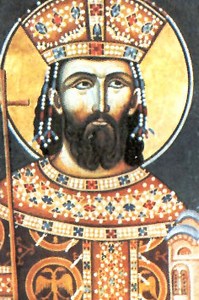
Portrait of Prince Lazar in the Monastery of Ravanica (1380s)
|
|
| Prince Martyr Autocrator of all the Serbs |
|
| Born | c. 1329 Fortress of Prilepac, Kingdom of Serbia |
| Died | 15 June 1389 (aged approximately 60) Kosovo Field, District of Branković |
| Venerated in | Eastern Orthodox Church |
Lazar Hrebeljanović (Serbian Cyrillic: Лазар Хребељановић; around 1329 – 15 June 1389) was an important Serbian ruler in the Middle Ages. He built the largest and strongest state in what was left of the Serbian Empire. Historians call Lazar's state Moravian Serbia. It included the areas around the Great Morava, West Morava, and South Morava rivers.
Lazar ruled Moravian Serbia from 1373 until he died in 1389. He wanted to bring back the Serbian Empire and lead it himself. He believed he was the rightful heir to the Nemanjić dynasty, which had ruled Serbia for 200 years but ended in 1371. The Serbian Orthodox Church fully supported Lazar's plan.
Lazar was killed at the Battle of Kosovo in June 1389. He was leading a Christian army against the invading Ottoman Empire, led by Sultan Murad I. The battle was very tough for both sides, with no clear winner. Lazar's wife, Milica, took over as ruler for their young son, Stefan Lazarević. She agreed to be under Ottoman rule in 1390.
Today, Lazar is honored in the Orthodox Christian Church as a martyr and saint. He is a very important figure in Serbian history, culture, and traditions. In Serbian epic poetry, he is often called Tsar Lazar, even though he was officially a prince (knez).
Contents
Prince Lazar's Story
Lazar was born around 1329 in the Fortress of Prilepac. This place was about 13 kilometers southeast of Novo Brdo, a big mining town. His family were the traditional lords of Prilepac. This fortress, along with Prizrenac, protected the mines and towns near Novo Brdo.
Lazar's father, Pribac, was a logothete (a type of chancellor) at the court of Stefan Dušan. Dušan was a member of the Nemanjić dynasty. He ruled as King of Serbia from 1331 to 1346 and then as Emperor (tsar) from 1346 to 1355. The logothete was not a very high rank. But Dušan had rewarded nobles who supported him, giving them higher positions. Pribac was one of these nobles.
Life at Court
Dušan also rewarded Pribac by giving his son Lazar a job as a stavilac at the royal court. A stavilac helped with royal meals. But they could also be given other important tasks. This title was the lowest in the Serbian court. Yet, it was still important because it meant being close to the ruler.
Lazar married Milica. Later family records from the 1400s say Milica was the daughter of Prince Vratko. Vratko was a great-grandson of Vukan. Vukan was the son of Stefan Nemanja, who started the Nemanjić dynasty. This dynasty ruled Serbia from 1166 to 1371.
Tsar Dušan died suddenly in 1355 when he was about 47. His 20-year-old son, Stefan Uroš V, took his place. Lazar stayed a stavilac at the new tsar's court. After Dušan's death, parts of the Serbian Empire started to break away. Regions like Epirus and Thessaly in the southwest became independent by 1359. The same happened with Braničevo and Kučevo in the northeast. These areas were controlled by the Rastislalić family. They chose to follow King Louis of Hungary.
The rest of Serbia stayed loyal to young Tsar Uroš. But even there, powerful Serbian nobles became more and more independent. Uroš was weak and could not stop these changes. He relied on the strongest Serbian noble, Prince Vojislav Vojinović. Vojislav started as a stavilac under Tsar Dušan. But by 1363, he controlled a large area. This area stretched from Mount Rudnik in central Serbia to Konavle on the Adriatic Sea coast. It also went from the Drina River to northern Kosovo.
The next most powerful nobles were the Balšić brothers: Stracimir, Đurađ, and Balša II. By 1363, they controlled the region of Zeta, which is mostly present-day Montenegro.
In 1361, Prince Vojislav started a war with the Republic of Ragusa (modern-day Dubrovnik). The people of Ragusa asked important Serbs to help stop the fighting. In 1362, they even gave stavilac Lazar a small gift. This shows that Lazar was seen as having some influence at Tsar Uroš's court. Peace was made in August 1362. Lazar is mentioned as a witness in a document from July 1363. This document showed Tsar Uroš approving a land exchange. It was between Prince Vojislav and čelnik Musa. Musa had been married to Lazar's sister, Dragana, since at least 1355. Musa's title, čelnik (meaning "headman"), was higher than stavilac.
Becoming a Leader
Lazar's actions between 1363 and 1371 are not well known. He likely left Tsar Uroš's court around 1363 or 1365. He was about 35 years old and still a stavilac. Prince Vojislav, the most powerful lord, died suddenly in September 1363. The Mrnjavčević brothers, Vukašin and Jovan Uglješa, then became the strongest nobles. They controlled lands in the south of the Empire, mainly in Macedonia.
In 1365, Tsar Uroš made Vukašin king, making him his co-ruler. Around the same time, Jovan Uglješa became a despot, a high court title. Nikola Altomanović, a nephew of Prince Vojislav, gained control of most of his late uncle's territory by 1368. Nikola was about 20 years old then. During this time, Lazar became independent and started his own rule. We don't know exactly how his territory grew. But it was not centered at his family's old fortress, Prilepac, which Vukašin had taken. Lazar's main area was somewhere between the Mrnjavčevićs in the south, Nikola Altomanović in the west, and the Rastislalićs in the north.
The book Il Regno de gli Slavi (The Realm of the Slavs) by Mavro Orbin, published in 1601, tells stories about Lazar. Some historians doubt these stories because no other sources confirm them. Orbin wrote that Nikola Altomanović and Lazar convinced Tsar Uroš to join them. They planned to attack the Mrnjavčević brothers. This battle supposedly happened on the Kosovo Field in 1369. Lazar left the battle early. His allies fought on but were defeated. Altomanović barely escaped, and Uroš was captured for a short time.
In 1370, Lazar took the town of Rudnik from Altomanović. Rudnik was a rich mining center. This might have happened because Altomanović was defeated the year before. But Altomanović quickly recovered with help from the powerful Kingdom of Hungary.
Prince and Ruler
It's not clear when Lazar officially became a knez (prince). The first record of his new title is from a Ragusa document dated April 22, 1371. It calls him Comes Lazarus, which was the Latin word for knez. This document also says Lazar held Rudnik at that time. In medieval Serbia, knez didn't always mean the same rank. It was a high rank in the 1100s, but lower in the 1200s and early 1300s. During Tsar Uroš's time, when the central government was weak, the title of knez became important again. The strongest regional lord, Vojislav Vojinović, held it until he died in 1363.
Rise to Power
The Ottoman Turks took Gallipoli from Byzantium in 1354. This was their first land in Europe. From there, the Ottomans moved into the Balkans. By 1370, they reached Serbian lands, specifically the Mrnjavčevićs' territory in eastern Macedonia. The Mrnjavčević brothers' army fought the Ottomans in the Battle of Marica on September 26, 1371. The Ottomans destroyed the Serbian army. Both King Vukašin and Despot Jovan Uglješa were killed.
Vukašin's son, King Marko, became Tsar Uroš's co-ruler. In December 1371, Uroš died without children. This ended the Nemanjić dynasty, which had ruled Serbia for two centuries. King Marko Mrnjavčević was officially the ruler of the Serbian state, but it had already broken apart. Powerful Serbian lords did not recognize him as their leader. They attacked the Mrnjavčevićs' lands. The Balšić brothers took Prizren and Peć. Prince Lazar took Priština and Novo Brdo, and got back his family's fortress, Prilepac. The Dragaš brothers, Jovan and Konstantin, created their own area in eastern Macedonia. King Marko was left with only a small area in western Macedonia. Jovan Uglješa's widow, Jelena, became a nun and lived with Prince Lazar and his wife Milica.
After the Mrnjavčević brothers died, Nikola Altomanović became the most powerful noble in the broken Serbian state. While Lazar was taking Priština and Novo Brdo, Nikola took Rudnik back from him. By 1372, Prince Lazar and Tvrtko, the Ban of Bosnia, formed an alliance against Nikola. Nikola lost the protection of Hungary because he worked with Venice, an enemy of Hungary. Lazar promised King Louis of Hungary to be his loyal follower if Louis supported him.
Prince Lazar and Ban Tvrtko attacked and defeated Nikola Altomanović in 1373. Nikola was captured in his stronghold, Užice. He was then given to Lazar's nephews, the Musić brothers, who blinded him. Lazar then accepted King Louis's rule.
Ban Tvrtko added parts of Zahumlje that Nikola held to his state. This included areas around the Drina and Lim Rivers. Prince Lazar and his relatives, Vuk Branković and čelnik Musa, took most of Nikola's lands. Vuk Branković, who married Lazar's daughter Mara around 1371, gained Sjenica and part of Kosovo. Lazar's relative, čelnik Musa, ruled an area around Mount Kopaonik with his sons, the Musić brothers. Djuradj Balšić took Nikola's coastal areas. Ban Tvrtko would take these lands in 1377.
In October 1377, Tvrtko was crowned king of the Serbs, Bosnia, Maritime, and Western Areas. Even though Tvrtko was Catholic, his crowning happened at the Serbian Monastery of Mileševa. King Tvrtko claimed the Serbian throne and the Nemanjić legacy. He was a distant relative of the Nemanjićs. Hungary and Ragusa recognized Tvrtko as king. There is no sign that Prince Lazar had any problems with Tvrtko's new title. However, Lazar did not see Tvrtko as his ruler. King Tvrtko also did not have the support of the Serbian Church. The Church was the only thing holding the broken Serbian state together.
Leading Serbia
After Nikola Altomanović's fall, Prince Lazar became the most powerful lord in the former Serbian Empire. Some local nobles tried to resist Lazar, but they eventually joined him. This happened with Nikola Zojić on Mount Rudnik and Novak Belocrkvić in the Toplica River valley.
Lazar's large and rich land became a safe place for Orthodox Christian monks. They were fleeing from areas threatened by the Ottomans. This made Lazar famous on Mount Athos, a major center for Orthodox monks. The Serbian Church (Serbian Patriarchate of Peć) had been separated from the Patriarchate of Constantinople since 1350. Constantinople was the main authority of Eastern Orthodoxy.
A Serb monk from Mount Athos, Isaija, encouraged Lazar to help bring the two churches back together. Lazar and Isaija worked together. A group was sent to the Patriarch of Constantinople to talk about peace. The group was successful. In 1375, the Serbian Church was welcomed back into communion with Constantinople.
The last Serbian Patriarch during the separation, Sava IV, died in April 1375. In October of that year, Prince Lazar and Djuradj Balšić held a meeting of the Serbian Church in Peć. Patriarch Jefrem was chosen as the new head of the Church. He was either Constantinople's choice or a compromise. Patriarch Jefrem stepped down in 1379. Spiridon took his place. Some historians think Lazar's influence caused this change. The prince and Patriarch Spiridon worked very well together. The Church was grateful to Lazar for ending the separation with Constantinople.
Lazar also gave land to monasteries and built churches. His most famous church is the Monastery of Ravanica, finished in 1381. Earlier, he built the Church of St Stephen in his capital, Kruševac. This church became known as Lazarica. After 1379, he built the Gornjak Monastery. He also helped start Romanian monasteries in Tismana and Vodiţa. He paid for some building work in two monasteries on Mount Athos: the Serbian Hilandar and the Russian St Panteleimon.
Lazar expanded his land to the Danube River in 1379. He took Kučevo and Braničevo, removing the Hungarian ruler Radič Branković Rastislalić from these areas. King Louis had given Lazar the region of Mačva earlier. This likely happened when Lazar accepted Louis's rule. This suggests Lazar might have rebelled against Louis. King Louis was planning a campaign against Serbia in 1378. It's not clear who he was planning to fight. It's also possible that Lazar's attack on Radič Branković Rastislalić had Louis's approval.
Lazar's state, called Moravian Serbia, was bigger than other lords' lands in the former Serbian Empire. It also had a better government and army. The state included the areas around the Great Morava, West Morava, and South Morava Rivers. It stretched from the South Morava's source north to the Danube and Sava Rivers. Its northwest border was along the Drina River. Besides the capital Kruševac, the state had important towns like Niš and Užice. It also had Novo Brdo and Rudnik, the two richest mining centers in medieval Serbia.
Lazar's state was furthest from Ottoman lands. This meant it was less attacked by Turkish raiding parties. This attracted people from Turkish-threatened areas. They built new villages in places that were not well populated before. There were also religious people among the immigrants. This helped old churches and monasteries in Lazar's state become active again or new ones to be built. The location of the Morava river basins was important. It made Lazar powerful in the Balkans because of the expected Turkish attacks.
In documents from 1379 to 1388, the prince called himself Stefan Lazar. "Stefan" was a name used by all Nemanjić rulers. It became a title for Serbian rulers. Tvrtko also added "Stefan" to his name when he became king of the Serbs and Bosnia. In his documents, Lazar called himself the autocrator (samodržac in Serbian) of all Serbian land, or of all the Serbs. Autocrator means "self-ruler" in Greek. It was a title used by Byzantine emperors. The Nemanjić kings used it to show they were independent from Byzantium.
During Prince Lazar's time, Serbia lost some lands. The remaining lands were divided among regional lords. The Nemanjić dynasty ended, and Turkish attacks increased. This raised questions about Serbia's future. Lazar's answer was in the titles he used. Lazar wanted to reunite the Serbian state under his rule. He saw himself as the direct successor of the Nemanjićs. The Serbian Church fully supported this goal. However, powerful regional lords ruled their own areas independently from Prince Lazar. These included the Balšićs in Zeta, Vuk Branković in Kosovo, King Marko, Konstantin Dragaš, and Radoslav Hlapen in Macedonia. Also, the three lords in Macedonia became Ottoman followers after the Battle of Marica. By 1388, Djuradj Stracimirović Balšić, the lord of Zeta, also accepted Ottoman rule.
A Turkish raiding party entered Moravian Serbia in 1381. They passed through lands of Ottoman followers without problems. Lazar's nobles, Crep Vukoslavić and Vitomir, defeated them in the Battle of Dubravnica, near Paraćin. In 1386, Ottoman Sultan Murad I himself led a much larger army. They took Niš from Lazar. It's not clear if the fight between Lazar's and Murad's armies at Pločnik happened before or after Niš was captured. Lazar pushed back Murad at Pločnik.
After King Louis I died in 1382, a civil war started in Hungary. Lazar seems to have been involved, fighting against Prince Sigismund of Luxemburg. Lazar might have sent troops to fight in the Belgrade and Syrmia regions. As the Ottoman threat grew and Sigismund gained more support in Hungary, Lazar made peace with Sigismund. Sigismund became Hungarian king in March 1387. The peace was sealed, probably in 1387, when Lazar's daughter Teodora married Nicholas II Garay. Nicholas was a powerful Hungarian noble who supported Sigismund. Around the same year, Lazar's daughter Jelena married Djuradj Stracimirović Balšić. About a year before, Lazar's daughter Dragana married Alexander, the son of Ivan Shishman, Tsar of Bulgaria.
The Battle of Kosovo

After the fight at Pločnik in 1386, Lazar knew a big battle with the Ottomans was coming. He made peace with Sigismund to avoid problems on his northern borders. Then, he got military help from Vuk Branković and King Tvrtko. King Tvrtko was also expecting a big Ottoman attack. His army, led by Vlatko Vuković, had destroyed a large Turkish raiding party in the Battle of Bileća in 1388.
A huge Ottoman army, led by Sultan Murad, arrived in June 1389. It had between 27,000 and 30,000 soldiers. They marched through Konstantin Dragaš's land and reached the Kosovo Field. This was near Priština, in Vuk Branković's territory. Lazar's forces met them. His army had between 12,000 and 30,000 soldiers. It included his own troops, Vuk Branković's troops, and soldiers sent by King Tvrtko.
The Battle of Kosovo, Serbia's most famous medieval battle, was fought on June 15, 1389. The fighting was fierce, and both sides lost many soldiers. Prince Lazar and Sultan Murad both died. Lazar was killed during the battle. Sultan Murad was killed after the battle by a Serbian nobleman named Miloš Obilić. Obilić pretended to join the Ottoman forces. When he was brought before Murad, he pulled out a hidden dagger and killed the Sultan. Murad's bodyguards then killed Obilić.
We don't have complete information about the Battle of Kosovo. It seems the battle was a draw. But the heavy losses were much worse for the Serbs. They had used almost all their fighting strength at Kosovo. Serbia under Prince Lazar was rich and had a good army. But it was much smaller than the Ottoman Empire.
Lazar's oldest son, Stefan Lazarević, took his place. Since Stefan was still young, his mother Milica ruled Moravian Serbia. Five months after the battle, Hungarian King Sigismund's troops attacked her from the north. When Turkish forces reached Moravian Serbia in the summer of 1390, Milica accepted Ottoman rule. She sent her youngest daughter, Olivera, to join Sultan Bayezid I's harem. Vuk Branković also became an Ottoman follower in 1392. Now, all Serbian lands were under Ottoman rule, except Zahumlje, which was under King Tvrtko.
A Saint and Hero
Lazar's Holy Status
After the Battle of Kosovo, Prince Lazar was first buried in the Church of the Ascension in Priština. This was in Vuk Branković's land. A year or two later, in 1390 or 1391, Lazar's relics (holy remains) were moved to the Ravanica Monastery. Lazar had built this monastery and wanted to be buried there. The Serbian Church and Lazar's family arranged the move. High church leaders, including Patriarch Danilo III, attended the ceremony. It was likely at this time that Lazar was made a saint, even though there is no written record of it. He was added to the list of Christian martyrs. His feast day is celebrated on June 15.
Writings by Patriarch Danilo and others say that Prince Lazar was captured and killed by the Turks. His death was seen as similar to early Christian martyrs who were killed by non-Christians. In a medieval state where the Church and State were closely linked, making someone a saint was not just a church act. It was also important for society. After 200 years of the Nemanjić dynasty, most of whom became saints, Lazar was the first non-clergyman to be recognized as a saint.
During his life, Lazar became very respected as the main lord in the former Serbian Empire. The Church saw him as the only ruler worthy and able to follow the Nemanjićs and bring back their state. His death was seen as a major turning point in Serbian history. The effects of the Battle of Kosovo were felt right away in Serbia. But the Battle of Marica 18 years earlier was more important in the long run. That defeat opened the Balkans to the Turks.
Lazar is honored as a saint and martyr in ten religious writings from Serbia. These were written between 1389 and 1420. Most were written closer to 1389. These writings helped spread the worship of Saint Lazar. Many were used in church services on his feast day. The Encomium of Prince Lazar by nun Jefimija is considered the best of these writings. Nun Jefimija (whose real name was Jelena) was related to Princess Milica. She was also the widow of Jovan Uglješa Mrnjavčević. After his death, she lived with Milica and Lazar. Jefimija embroidered her Encomium with gold thread on the silk cloth covering Lazar's relics.
Lazar's son and successor, Stefan Lazarević, is thought to have written the text carved on a marble pillar. This pillar was put up at the site of the Battle of Kosovo. The Ottomans destroyed the pillar, but the text is saved in a 1500s manuscript. Patriarch Danilo III wrote Narration about Prince Lazar around the time Lazar's relics were moved. This writing gives the most historical information. It combines stories of saints, praise, and sermons. The prince is celebrated as both a martyr and a warrior. The patriarch wrote that the Battle of Kosovo ended when both sides were tired. Both Serbs and Turks had heavy losses. The main part of Narration is the patriarch's version of Lazar's speech to his warriors before the battle:
You, O comrades and brothers, lords and nobles, soldiers and vojvodas—great and small. You yourselves are witnesses and observers of that great goodness God has given us in this life... But if the sword, if wounds, or if the darkness of death comes to us, we accept it sweetly for Christ and for the godliness of our homeland. It is better to die in battle than to live in shame. Better it is for us to accept death from the sword in battle than to offer our shoulders to the enemy. We have lived a long time for the world; in the end we seek to accept the martyr's struggle and to live forever in heaven. We call ourselves Christian soldiers, martyrs for godliness to be recorded in the Book of Life. We do not spare our bodies in fighting in order that we may accept the holy wreathes from that One who judges all accomplishments. Sufferings beget glory and labours lead to peace.
With Lazar's death, Serbia lost its strongest regional ruler. He might have been the last hope against the growing Ottomans. This loss could have led to sadness and hopelessness. The writers of the holy texts said that Lazar and his thousands of warriors died on the Kosovo Field as martyrs for their Christian faith and for Serbia. Sultan Murad and his army are described as cruel, godless, and savage. Prince Lazar, through his sacrifice, stays forever among the Serbs as a good leader.
His worship was added to other important holy figures in medieval Serbia. These included the first Nemanjić saints—Saint Simeon and his son Saint Sava. These holy figures helped unite the Serbs into a strong religious and political group. However, Lazar was still less famous than Saint Sava and Saint Simeon.
Lazar's son, Stefan Lazarević, became a despot (a high title) from the Byzantine Emperor. He stopped being an Ottoman follower in 1402. During his rule, Holy Prince Lazar was probably honored throughout Moravian Serbia. He was also honored in two monasteries on Mount Athos: the Serbian Hilandar and the Russian St. Panteleimon. Lazar had paid for some building work in these monasteries. Only one image of Lazar is known from Despot Stefan's time. It is a painting in the Ljubostinja Monastery, built around 1405 by Princess Milica. Lazar is shown there with royal symbols, not saintly ones. His next image would not appear until 1594. It was painted among many other people in the Orahovica Monastery in Slavonia. For his holy status, the writings were more important than pictures.
Despot Stefan Lazarević died suddenly in July 1427. His successor was Despot Đurađ, Vuk Branković's son and Lazar's grandson. At the start of his rule, Đurađ wrote a document calling Lazar a saint. But when he reissued the document in 1445, he avoided calling Lazar a "saint." Instead, he used "resting in holiness." This avoidance of calling him a saint can be seen in other documents from that time. This includes those written by his daughter Jelena.
During Ottoman Rule
The Serbian Despotate fell to the Ottomans in 1459. The honoring of Holy Prince Lazar became a local practice, mainly at the Ravanica Monastery. Its monks continued to celebrate his feast day every year. The prince had given 148 villages and special rights to the monastery. The Ottomans reduced its property to a few villages, but they did not make Ravanica pay some taxes. An Italian traveler, Marc Antonio Pigafetta, visited Ravanica in 1568. He said the monastery was never damaged by the Turks. The monks could practice their religion freely, but they were not allowed to ring bells.
Saint Lazar was honored at the court of Ivan the Terrible, the first Russian tsar (1547–1584). Ivan's grandmother on his mother's side was from the Serbian noble family of Jakšić. Lazar appears in a painting in the Cathedral of the Archangel. This is where Russian rulers are buried in the Moscow Kremlin. The walls of the cathedral were painted in 1565. They showed all Russian rulers before Ivan the Terrible. Only four non-Russians were shown: Byzantine Emperor Michael VIII Palaiologos and three Serbs—Saints Simeon, Sava, and Lazar. The prince is also shown in the Illustrated Chronicle of Ivan the Terrible. It has nine small pictures showing the Battle of Kosovo. In this Russian book, Prince Lazar was called a tsar for the first time. Around 1700, Count Đorđe Branković wrote his Slavo-Serbian Chronicles. In it, he claimed that Lazar was crowned tsar. This influenced Serbian folk stories, where the prince is still known as Tsar Lazar. After Ivan the Terrible died, Lazar is rarely mentioned in Russian sources.
Lazar's worship in his Ottoman-held homeland, mainly at Ravanica Monastery, grew stronger during the time of Serbian Patriarch Paisije. In 1633 and the years after, Lazar was painted in the church of the Patriarchal Monastery of Peć and three other Serbian churches. Patriarch Paisije wrote that Serbian Tsar Dušan adopted Lazar. He also said Dušan gave Lazar his relative, Princess Milica, in marriage. This made Lazar the rightful successor to the Nemanjić dynasty. In 1667, the prince was painted on a wall in the Hilandar Monastery. The same painter created an icon showing Lazar with Đorđe Kratovac. Kratovac was a goldsmith killed by the Turks and recognized as a martyr. In 1675, Prince Lazar and several Nemanjićs were shown in an icon. This icon was ordered by the brothers Gavro and Vukoje Humković, Serbian craftsmen from Sarajevo. Lazar's images from this time show him more as a ruler than as a saint. The only exception is the icon with Đorđe Kratovac.
After the Great Serb Migration
During the Great Turkish War in the late 1600s, the Habsburg monarchy took some Serbian lands from the Ottomans. In 1690, many Serbs living in these lands moved to the Habsburg Monarchy. This happened as the Habsburg army retreated from Serbia before the Ottomans. This move, known as the Great Serb Migration, was led by Arsenije III Čarnojević, the patriarch of the Serbian Church.
The Ravanica monks joined the move north. They took Lazar's relics and the monastery's treasures with them. They settled in the town of Szentendre. They built a wooden church there and put the relics in it. They built houses around the church and named their new settlement Ravanica. Szentendre also became the temporary home of Patriarch Arsenije III.
The Ravanica monks connected with Serbian monasteries in the Habsburg Monarchy. They also connected with the Russian Orthodox Church, which helped them. They greatly increased their library and treasures while in Szentendre. During this time, they started using printing to spread the worship of the Holy Prince. They made a woodcut showing Lazar as a cephalophore (a saint carrying his own head). In 1697, the Ravanica monks left Szentendre. They moved to the old Monastery of Vrdnik-Ravanica on Mount Fruška Gora. They fixed it up and put Lazar's relics in its church. This monastery then became the center of Lazar's worship. It soon became known more often as Ravanica than Vrdnik. By the mid-1700s, people generally believed that Prince Lazar himself had founded the monastery. Its church became too small for all the people who gathered there on holidays.
The Treaty of Passarowitz was signed on July 21, 1718. It gave Serbia north of the West Morava River from the Ottoman Empire to the Habsburg Monarchy. At that time, only one of the original Ravanica monks who left their monastery 28 years earlier was still alive. His name was Stefan. Shortly before the treaty, Stefan returned to Ravanica. He fixed up the monastery, which was half-ruined and overgrown. In 1733, there were only five monks in Ravanica. Serbia was returned to the Ottoman Empire in 1739. But the monastery was not completely left empty this time.
After the Great Serb Migration, the highest church leaders of the Serbian Church actively promoted the worship of Serbian rulers who had become saints. Arsenije IV Šakabenta, Metropolitan of Karlovci, hired engravers in 1741. They created a poster called "Saint Sava with Serbian Saints of the House of Nemanja." Lazar was also shown on it. Its purpose was not just religious. It was also to remind people of the independent Serbian state before the Ottoman conquest. It also reminded them of Prince Lazar's fight against the Ottomans. The poster was shown at the Habsburg court.
The same engravers made a book called Stemmatographia, published in Vienna in 1741. Part of it had pictures of 29 rulers and saints. Among them were two cephalophores, Jovan Vladimir and Lazar. Stemmatographia was very popular among Serbs. It made them feel patriotic. The Holy Prince would often be shown as a cephalophore in later artworks. A unique image of Lazar is a 1773 copperplate by Zaharije Orfelin. In it, the prince looks like he is in a parade, without saintly symbols except a halo.
Lazar's relics stayed in the Monastery of Vrdnik-Ravanica until 1941. Shortly before Nazi Germany attacked Yugoslavia, the relics were moved to the Bešenovo Monastery. This was also on Mount Fruška Gora. Syrmia became part of the Nazi puppet state of Croatia. This state was controlled by the fascist Ustaše movement. They carried out large-scale killings against Serbs. The leader of Vrdnik, Longin, escaped to Belgrade in 1941. He reported that Serbian holy objects on Fruška Gora were in danger. He suggested moving them to Belgrade. The Synod of the Serbian Orthodox Church agreed. On April 14, 1942, after German authorities gave permission, the box with Lazar's relics was moved. It went from Bešenovo to the Belgrade Cathedral Church. It was ceremonially placed in front of the iconostasis in the church. In 1954, the Synod decided the relics should go back to the Ravanica Monastery. This happened in 1989, on the 600th anniversary of the Battle of Kosovo.
Legacy and Tradition
In Serbian epic stories, it is said that the night before the Battle of Kosovo, Lazar was visited by a grey hawk or falcon from Jerusalem. This bird offered him a choice: an earthly kingdom (meaning victory at Kosovo) or a heavenly kingdom (meaning a peaceful surrender or a bloody defeat).
-
- "...the Prophet Elijah then appeared as a gray falcon to Lazar, bearing a letter from the Mother of God that told him the choice was between holding an earthly kingdom and entering the kingdom of heaven..."
According to these stories, Lazar chose the eternal, heavenly kingdom. Because of this, he died on the battlefield. "We die with Christ, to live forever," he told his soldiers. This choice and promise from Kosovo is seen as a special agreement the Serb people made with God. They sealed it with the blood of martyrs. Since then, Serbs who believe in this promise see themselves as God's people. They are Christ's new nation, heavenly Serbia, part of God's New Israel. This is why Serbs sometimes call themselves the people of Heaven.
Jefimija, the former wife of Uglješa Mrnjavčević and later a nun, embroidered the Praise to Prince Lazar. This is one of the most important works of medieval Serbian literature. The Serbian Orthodox Church made Lazar a saint, known as Saint Lazar. He is celebrated on June 28 (or June 15 by the old calendar) on a day called Vidovdan. Several towns and villages (like Lazarevac), small Serbian Orthodox churches, and missions around the world are named after him. His remains are kept in Ravanica Monastery.
Titles and Family
It is not certain when Lazar first used the title knez. This title is usually translated as "prince" or "duke". The earliest record of Lazar's new title is from a Ragusa document in Latin, dated April 22, 1371. It calls him Comes Lazarus. Ragusa used comes as a Latin translation of the Slavic title knez. The same document says Lazar held Rudnik at that time.
In medieval Serbia, knez was not a fixed title. Its rank was high in the 1100s, but a bit lower in the 1200s and early 1300s. During Tsar Uroš's rule, when the central government was weak, the title of knez became very respected again. The most powerful regional lord, Vojislav Vojinović, held it until he died in 1363.
Between 1374 and 1379, the Serbian Church recognized Lazar as the "Lord of Serbs and Podunavlje" (meaning the Danube region). In 1381, he signed himself as "knez Lazar, of Serbs and Podunavlje." In a carving from Ljubostinja dated 1389, he is called "knez Lazar, lord of all Serbs and Danube provinces." In Hungary, he was known as the "Prince of the Kingdom of Rascia."
In documents from 1379 to 1388, he called himself Stefan Lazar. "Stefan" was a name used by all Nemanjić rulers. It was seen as a title for Serbian rulers. Tvrtko also added "Stefan" to his name when he became king of the Serbs and Bosnia. In his documents, Lazar called himself the autocrator (samodržac in Serbian) of "All Serbian Lands" or the autocrator of "All the Serbs." Autocrator, meaning "self-ruler" in Greek, was a title of Byzantine emperors. The Nemanjić kings used it to show they were independent from Byzantium.
Lazar's Children
Lazar and Milica had at least eight children. They had five daughters and three sons:
- Mara (died April 12, 1426), married Vuk Branković around 1371.
- Dragana (died before July 1395), married Bulgarian Tsar Ivan Shishman around 1386.
- Teodora (died before 1405), married Hungarian noble Nicholas II Garay around 1387.
- Jelena (died March 1443) married first Zetan lord Đurađ II Balšić, then Bosnian noble Sandalj Hranić.
- Maria Olivera Despina (1372–1444), married Ottoman Sultan Bayezid I in 1390.
- Dobrovoj. Died at birth.
- Stefan (around 1377–July 19, 1427), prince (1389–1402) and despot (1402–1427).
- Vuk, prince, executed on July 6, 1410.
Images for kids
See also
 In Spanish: Lazar de Serbia para niños
In Spanish: Lazar de Serbia para niños


